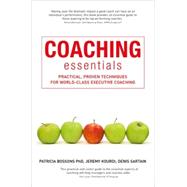
| Succeeding as a coach | p. 1 |
| The case for coaching | p. 3 |
| Essential skills for coaches | p. 9 |
| Typical challenges for coaches | p. 19 |
| Clients worry about 'being found out' | p. 23 |
| Clients want to communicate better with colleagues | p. 24 |
| A client has recently been appointed to a senior position | p. 25 |
| The client is unsure about where to start with their issues | p. 26 |
| The client is uncertain about what they want | p. 27 |
| Clients can't relate to (or don't work well with) their boss or colleagues | p. 28 |
| New team, fast results | p. 29 |
| Need to have a tough conversation | p. 30 |
| Difficulties managing time or achieving a work-life balance | p. 31 |
| Clients have recently arrived from somewhere completely different-what should they do here? | p. 32 |
| The client is dealing with guilt | p. 34 |
| Clients need to be more creative | p. 35 |
| The client is working with people from different cultures | p. 36 |
| A client needs to be more of a 'people person' | p. 37 |
| Clients want to maintain their motivation | p. 38 |
| Clients want to develop their career | p. 39 |
| Struggling to deal with change | p. 41 |
| Feeling lonely at the top | p. 42 |
| Dealing with different generations | p. 43 |
| Clients lack confidence, self-esteem, skills or ability, or feel they're too young or too old (or any other specific limiting beliefs) | p. 46 |
| Contracting | p. 47 |
| Selling yourself as a coach | p. 48 |
| Time-keeping and ending a coaching session | p. 49 |
| Clients need to think long term and plan for the future | p. 50 |
| Getting the right coaching supervision | p. 52 |
| Difficult challenges for coaches | p. 55 |
| Coaching tools and useful models | p. 65 |
| Grow | p. 70 |
| Universal | p. 70 |
| Managing stress | p. 72 |
| Personal development and career planning | p. 76 |
| Using emotional intelligence | p. 79 |
| The Myers-Briggs type indicator (MBTI) | p. 83 |
| Mentoring | p. 87 |
| Visualisation and future orientation | p. 90 |
| Coaching supervision | p. 94 |
| Succeeding in a new job | p. 96 |
| Setting objectives and SMART goals | p. 102 |
| Achieving a sense of purpose | p. 104 |
| Assess, challenge and support | p. 106 |
| Transcending limiting beliefs | p. 108 |
| Circles of excellence | p. 109 |
| Well-formed outcomes | p. 111 |
| Questioning | p. 115 |
| Reframing | p. 117 |
| Teach me | p. 119 |
| Heron's six categories of intervention | p. 120 |
| Decisions and problem-solving | p. 122 |
| Force field analysis | p. 122 |
| Miracle question | p. 125 |
| Problem-solving | p. 127 |
| The decision-making process | p. 131 |
| Decision-making principles and techniques | p. 135 |
| The leadership pipeline | p. 140 |
| Kotter's eight-stage process for leading change | p. 144 |
| Eight principles of motivation | p. 147 |
| Enhancing motivation | p. 150 |
| Empowerment | p. 153 |
| The four stages of achieving emotional commitment | p. 156 |
| Action-centred leadership | p. 158 |
| Leadership styles | p. 161 |
| Teamworking (Belbin's team types) | p. 164 |
| Leading leaders | p. 168 |
| Developing influence (the Thomas-Kilmann conflict instrument) | p. 170 |
| Managing cross-cultural relationships and behaviour | p. 173 |
| Managing different generations | p. 179 |
| Defusing tensions (acknowledge, ask, answer) | p. 181 |
| Developing business relationships | p. 183 |
| The meta-mirror | p. 185 |
| Logical levels | p. 187 |
| Inspiring trust | p. 190 |
| Fundamental interpersonal relations orientation (FIRO-B) | p. 194 |
| 360-degree feedback | p. 196 |
| Prioritising and managing your time | p. 198 |
| Balancing work and personal life | p. 201 |
| The wheel of life | p. 203 |
| Thinking strategically | p. 205 |
| The balanced scorecard | p. 210 |
| Scenario thinking | p. 212 |
| Avoiding active inertia and moving from good to great | p. 215 |
| Developing innovation | p. 219 |
| Six thinking hats | p. 223 |
| Disney creativity strategy | p. 225 |
| Bibliography and further reading | p. 229 |
| Index | p. 233 |
| Table of Contents provided by Ingram. All Rights Reserved. |
The New copy of this book will include any supplemental materials advertised. Please check the title of the book to determine if it should include any access cards, study guides, lab manuals, CDs, etc.
The Used, Rental and eBook copies of this book are not guaranteed to include any supplemental materials. Typically, only the book itself is included. This is true even if the title states it includes any access cards, study guides, lab manuals, CDs, etc.